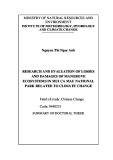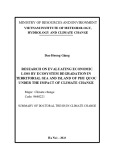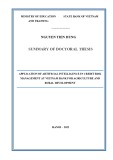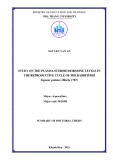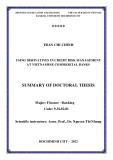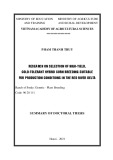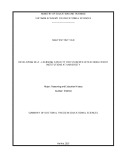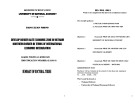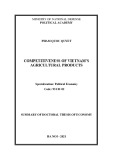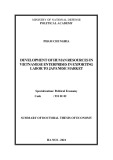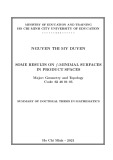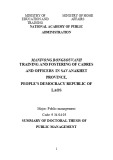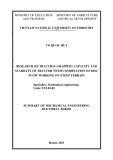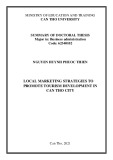
24
4.2.3.Assessment of cell viability
Most of the thawed cells can attach surface of culture flasks. In
addition to characteristics described above, another defining feature that
thawed osteoblast still kept was their morphology. These observations
clearly showed cryopreserved osteoblast could be stored and maintained
hight degrees of viability and differentiation potential. With these
results, we believed that cryopreserved osteoblast might become
promising candidate cell source for cell –based therapy.
CONCLUSIONS
1. Isolation, identify and culture successfully mesenchymal stem cells
from the rabbit bone marrow, thereby providing a summary process
for important steps such as anesthesia, position, aspirated marrow
technology, isolation, culture mesenchymal stem cell (identified as
mesenchymal stem cell).
2. Differentiation successful bone marrow mesenchymal stem cell into
osteoblast. After cell differentiation were identified by
immunohistochemistry with antibody osteocalcin, staining with
Alizarin red, observation of mineral crystal under scanning electron
microscope. The result confirm the differentiation mesenchymal
stem cell into osteoblast. Cryopreservation cell after differentiation
by slow freezing, rapid thawing in freezing medium 10% DMSO,
15% FBS. After thawing, viability rate over 80%. Most of the
thawed cells can attach surface of culture flasks, cell is still
developing well, cell shape is unchanged.
RECOMMENDATIONS
1. Optimal protocol of isolation, culture, differentiation mesenchymal
stem cells towards osteoblast from human bone marrow.
2. Apply autologous grafting mesenchymal stem cell differentiation
osteoblast for patient, who graft bone tissue and bone disease.
1
BACKGROUND
Partial loss of a bone of the extremities due to trauma, tumor
excision, bone disease, etc… presents as a substantial impediment
throught the life of patients, and numerous efforts have been made to
reconstruct the normal function of the skeletal system. However, such
efforts still have many limitations and problems. When using bone
graft, problems may develop in the donor area in general autologous
bone graft and immunological problems while the spread of disease
may also develop in allografts.
Despite advanced and optimized surgical procedures,
approximately 5% fracture sustained annually in the United states fail to
achieve bony union. There may be faster patient recovery and an absence
of these problems when stem cell are used. Cell culture has large numbers.
Cell differtiation, they would be expected to become a useful cell source
for treatment, has become more research favorable in the world and
Vietnames. Therefore, the maintenance of stem cell initial characteristics is
crucial, and it may be possible to preserve them by satisfactory
cryopreservation technologies. This is expeccially significant because the
supply of stem cells that are limited could be happed any time.
In fact, if long term cryopreserved stem cell still retained biological
ability, they would be expected to become a useful source for
regenerative medical progression.
Everyday, our laboratories we provide bone tissue for 10 patient to
autograft and allograft. Purpose bone tissue engineering conjugate with
stem cell engineering that can regenerate bone tissue with an appropriate
structure and function. Therefore, we conducted “experimental research
to apply protocol culture and cryopreservation of osteoblast from
differentiation bone marrow mesenchymal stem cell”.
Objective:
1. Isolation, identification and culture successfully mesenchymal
stem cell sample from rabbit bone marrow.
2. Differentation mesenchymal stem cell towards the osteoblast
and cryopreservation cell after differentiation.





